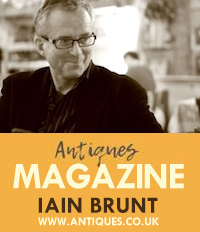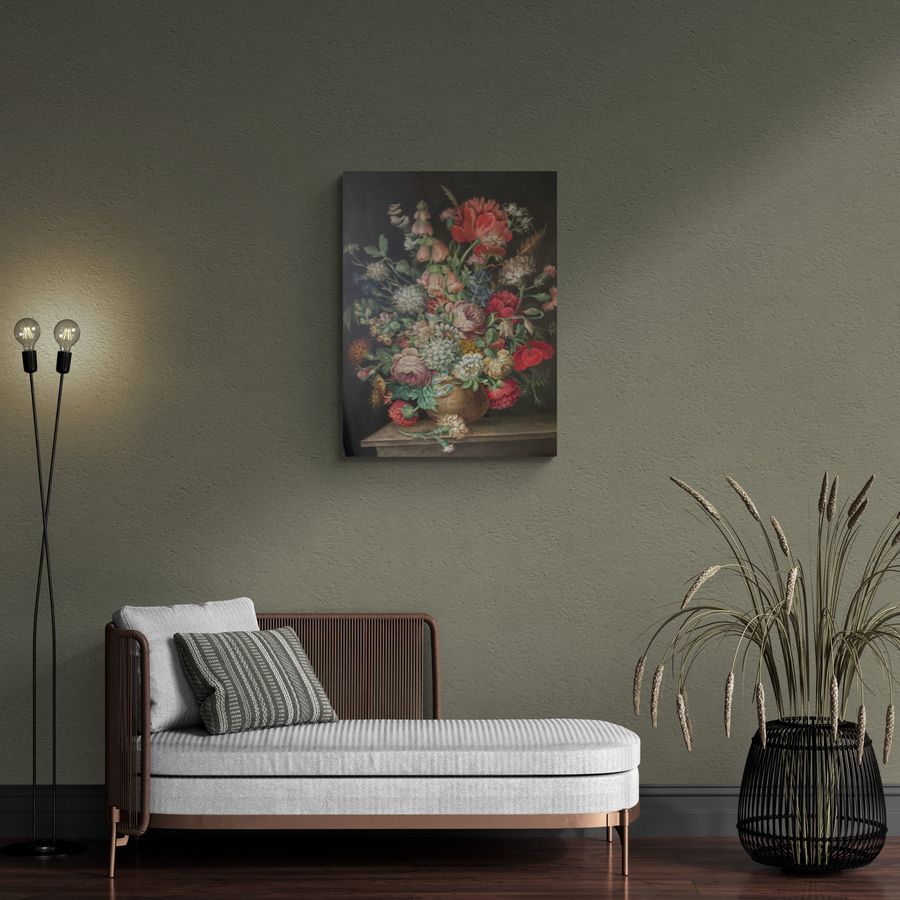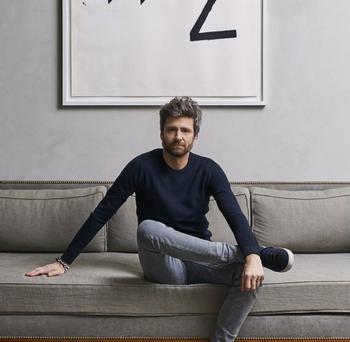Joseph Dirand
Posted by Alain Elkann on 15/09/2020
THE MINIMALIST WITH MAXIMUM EXPRESSION. Joseph Dirand is an architect and interior designer based in Paris. He started his own design firm in 1999.
Joseph Dirand, you are the son of a famous photographer of interiors, Jacques Dirand. Your brother Adrien follows your father’s steps by becoming a photographer. Instead, since you were very young, you decided to be an architect. Why?
My father became a photographer because of his passion for architecture.
He hunted all his life to capture through his lens the most beautiful and extraordinary places around the globe. I grew up surrounded by those images, which naturally inspired me to become an architect and eventually being able to create things that he would be proud to photograph.
You started your activity when you were very young and became well known for the first apartment that you redesigned facing the Place de la Concorde in Paris. What was so special about it?
I created my studio at the age of 23, right after my graduation. I have always felt the need to be independent probably due to the fact that my parents were both artists and independent and were surrounded by a lot of creative minds. I started my career doing small projects, but I put in a lot of effort to succeed in my dream. One day I was called to make this extraordinary apartment facing Place de la Concorde. It is very iconic because it has a huge curved window, behind which every Parisian was wondering what was happening. I used my first opportunity of working in such an iconic place to create something more radical and engaging, by reducing the interior and the decor to the minimum, considering the view to be stronger than the décor. It was about revealing the experience of living in silence in an unique urban landscape. This apartment was published in so many magazines that it was hard to believe the success of this minimal statement.
“I try to select projects that bring new challenges.”

Girafe Restaurant in Paris has an Art Deco design, a modern seafood menu and a ravishing terrace.
Photo: Adrien Dirand
Joseph Dirand, later you created a new shop for Balmain which has been called the most beautiful fashion store in Paris. Why was it so beautiful?
This project was also very important in my career, because instead of looking to create a new concept for a store I tried to recreate the brand into the context of a legacy that expressed the idea of the golden era of French couture. In the classical environment where Pierre Balmain had lived and worked I placed a sculptural mirror vertical monolith in the center of the room. That transported the historical context into the future in a strong dialogue between ornament and abstraction. I converted a retail space into a residential experience, and this got a lot of attention from the fashion world.
Because of the success of the Balmain store you designed many other projects for fashion companies such as Balenciagain Paris, Chloé in Paris and Shanghai, Alexander Wang in Beijing, Pucci in New York, Givenchy in Paris. Do you have a special recipe for fashion stores?
After this experience with Balmain I was called by several great fashion brands to collaborate with them and to design their new flagship store concept. What was very surprising was that those brands are so different from each other. That meant they didn’t decide to work with me because of a certain style, but probably more because of a certain way of translating their identity and history into a new experience. This period was extremely inspiring for me because with every project I had to reinvent myself, and this helped me to experiment with a new vocabulary and to escape to the idea of style.
You also designed several restaurants, among them ‘Loulou’ ‘Le Flandrin’ and ‘Monsieur Bleu’ in Paris. What is your concept in these restaurants?
I had the fantastic opportunity to design restaurants in the most beautiful museums in Paris, like ‘Monsieur Bleu’ in Palais de Tokyo, ‘Loulou’ in the Louvre, and ‘Girafe’ in Palais de Chaillot. They are all very different in style, and are dialoguing with the environment and their historical context. Through their success I realized the impact of creating spaces for people to experience in restaurants and hotels, and decided to try to focus my work on hospitality projects. But instead of designing around a function it became creating moments and memories, like creating a movie set but in real life. Since then I have done a restaurant in Miami called ‘Le Sirenuse’ and two Michelin star restaurants in New York, ‘Le Jardinier’ and ‘Shun’, and I am working on some others at the moment.
You also designed hotels. ‘Habitat’ in Monterey, ‘Distrito’ in Mexico City, ‘Surf Club’ in Miami together with Richard Meierand India Mahdavi, ‘Lapoge’ in Coeur Cheval. Among all these projects of hotels, restaurant and fashion stores, is there a ‘fil rouge’ that characterizes your work?
For me the hotel projects are the ones that combine everything. A hotel is both private and public; when you experience a new home for few days you want to feel where you are. It is so exciting to imagine that every day new guests are living their own experience of something that you have designed for them. Recently I decided to develop a collection of extraordinary holiday homes for rental service, like an hotel. This opens a new chapter for me by creating my own brand of hotel. Our first project will be in Italy.
Your early work was defined as minimalist, monochromatic, with a large use of black and white. Have you changed?
My work has constantly evolved during those first 23 years since starting from a blank page. I started with a very minimal black and white architecture that has evolved project after project, adding layers after layers to create projects that always try to be different and contextual. People always want to put a tag on my work and to identify my style clearly, but I prefer to live this creative life as a journey full of surprises and new challenges, and I have no idea how my work will evolve.
You use a lot of marble in your work. Is it true that you personally go to Carrara in Italy to choose the marble blocks?
Yes. I love the sourcing of those natural materials and, like a chef going into the market, I love to go hunting for the most beautiful block of marble for my project.
What do you mean when you say that you design “spaces that are alive”?
The idea is that the most important aspect of architecture is how it interacts with people, and the success of those places depends on the experience people are living.
“I get inspired feeling the intensity of nature.”
Joseph Dirand, in the construction of your work do you give a lot of importance to the surrounding nature?
I don’t think there is anything more inspiring than creating architecture in a place of natural wonder, like my favourite house, Casa Malaparte in Capri. The power of this dialogue between architecture and nature is a form of absolute. I will always try to find opportunities to work in those natural environments, even if most of the projects happen to be in the urban environment. I am currently working on an extraordinary project of a virgin island in the archipelago of Exuma in the Bahamas called ‘Norman’s Cay’. After four years’ work we are only now starting the construction of a series of private houses in this paradise of turquoise water and white sand beach. We had to create the infrastructure, the private airport and the marina, before being able to live on this island. The vision is global and this will be a lifetime project.
In your studio how many new projects do you undertake and how many people work with you?
My studio is composed of twenty-five passionate architects and designers. Our projects are the result of this team work and the dialogue between us. We feel proud to be able to work on such exciting projects, and we are normally working on around fifteen projects at the same time.
It seems that your city Paris has inspired your work very much. How come?
I grew up in Paris, so I believe this city has influenced me in many ways, primarily with its beauty, with so many extraordinary buildings. I like the classicism of it, the importance of craftsmanship, and the very strong ideas about lifestyle.
They say that you are a minimalist not only in your architecture but also in your way of dressing. Is that correct?
I am minimalist in my work because I try hard to express the maximum but try to keep it to the essential. And maybe I am minimalist in my way of dressing, because I just wear sober clothes that I take from the top of the shelf.
You did a lot of travelling in remote places like the Patagonian Desert. What are you looking for?
I travel because I am curious, and I want to witness the beauty of this planet and discover different cultures. They are the best moments of my year, finding new vistas to explore, and I get inspired feeling the intensity of nature. The experience of so many different hotels and lodges contributes to my being able to reset and start again with a fresh mind.
What are your criteria when you find yourself in front of a new space that you have to recreate?
I try to select projects that bring new challenges. I prefer it when projects are very different to what I have done before. This forces you to reinvent yourself and discover new things, to keep the excitement high.

Dirand Residence © Adrien Dirand

In New York City, Le Jardinier‘s modern, light-filled space is a journey into a serene lush indoor garden. ©Adrien Dirand

J.M. Weston shoes. © Adrien Dirand

Girafe © Adrien Dirand

SHUN in New York City calms the senses with its neutral palette and rich materials © Adrien Dirand

Dirand Residence © Adrien Dirand
“What is the story behind this moment?”
Joseph Dirand, some architects believe architecture to be vertical; others like David Adjaye believe it should be more horizontal. What is your personal opinion?
I believe it all depends on the context. Vertical in the city, and horizontal whenever you can.
Is there a big difference between design of private space like an apartment and design of public space like a hotel, shop, or restaurant?
Yes. A private space is created in dialogue with the owners who will live their family life, so the client becomes the context as much as the project itself. It is specific, because it is for them. Whereas a public place is a space you create for a large number of people to experience, so the question becomes: what is the story behind this moment? It also allows you to share your work with a larger public.
You also design furniture which you describe as an homage to modernist architecture. What kind of furniture is it?
A few years ago I started to design pieces of furniture outside of the context of a project. They were not a separate element of a story, but an independent object. The pieces are very architectural, and my first series of furniture was a tribute to the modernist period through constructivist line and strong materiality.
Is it true that your heroes are Carlo Scarpa, Alvar Aalto, Le Corbusier and Pierre Jeanneret?
These are just a few of the visionaries whose work I admire. There are others, like Oscar Niemeyer, John Lautner, Eero Sarineen, Mies van der Rohe, Peter Zumthor; and so many others that inspire me. Most of them create both architecture and interiors.
In conclusion, what are your new projects and are they affected by the corona virus?
I am currently working on two big residential buildings, in Miami and New York, in which I design both the architecture and the interior. We are also currently converting the previous US Embassy in Grosvenor Square in London, which was designed by the Finnish-American architect Eero Saarinen, into a luxury hotel for Rosewood in collaboration with David Chipperfield. I am also working on the most complex and exciting project I have ever worked on, a private explorer yacht of 118m that we have completely designed, from the hull and the superstructure down to the smallest interior details. It is a puzzle of millions of pieces composed around the idea of traveling in remote places to explore the beauty of this planet. The boat is under construction and will be in the water in less than two years. This was my first experience of boat building, so I had to learn everything and I surrounded myself with the best engineering team to support this vision. We are working on long term projects, so we don’t yet feel the impact of this crisis, though no doubt they will be affected in the future. I prefer to believe that this nightmare will soon find an end, and think about all the people who are really suffering today.
Portrait of Joseph Dirand 2020 © Adrien Dirand – Art by Jannis Kounellis






